






In Military Region II, training was accomplished at the Artillery School and the Vietnamese division training centers; II Field Force Artillery reoriented the Civilian Irregular Defense Group Artillery School to prepare territorial forces to assume the artillery mission. In Military Region IV, the Vietnamese Corps Artillery established a training center for the Regional Forces artillerymen. With at least part of the light artillery problem solved, planners in Saigon attacked the Vietnamese long-range fire power weakness. After thorough investigation, Project ENHANCE was promulgated. This plan authorized the activation and deployment of five 175-mm. gun battalions. Three of these battalions were scheduled for deployment in Military Region I. The remaining two battalions were projected for Regions II and III. Two battalions were to be trained, equipped, and deployed along the demilitarized zone in 1971 to replace withdrawing American units.
Operations Into Cambodia
Although commanders throughout Vietnam were placing primary emphasis on Vietnamization and the structure of the program was taking shape, the American effort and the ability of Vietnamese forces to absorb it had not had a significant test. The vehicle through which the Vietnamese fighting potential could be tested and its progress more reliably gauged was rapidly approaching in the spring of 1970.
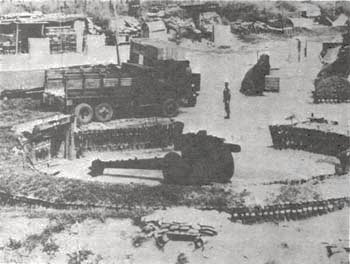
The sanctuaries and base areas established by the Communist forces along the South Vietnam-Cambodia boundary had long been a frustrating irritant to both American and Vietnamese military leaders.
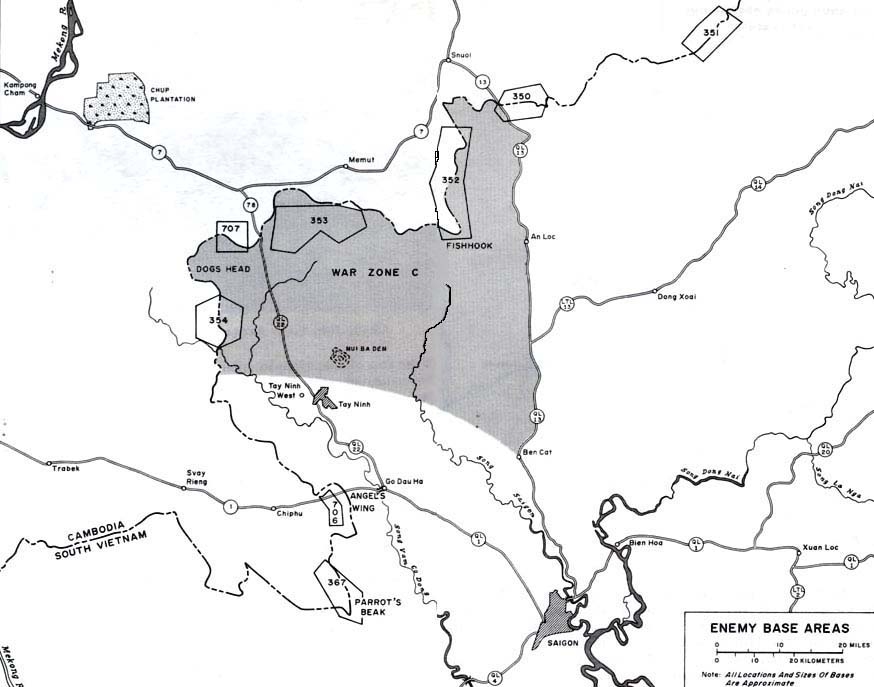
(Map 20)
Although the occupation of these areas by the North Vietnamese was a flagrant violation of Cambodian neutrality, the position taken by Prince Sihanouk and his government made it impossible to conduct operations across the border in an effort to deny the enemy the free use of these sanctuaries. Sihanouk's neutrality was flexible, ranging from open hostility toward South Vietnam and her allies to a more agreeable tolerance of the North Vietnamese and the Viet Cong. Over the years, this tolerance permitted the establishment and maintenance of these base areas.
In the spring of 1970 the political atmosphere in Cambodia changed drastically and erupted into violence, which culminated in the overthrow of the Sihanouk regime. With the formation of the Lon Nol administration, the attitude of the Cambodian government changed completely; its hostility was directed away from the South Vietnamese and against the Communists. This reversal of position made possible the subsequent incursions into Cambodia.
Intelligence reports had been indicating a massive logistics buildup in the Cambodian sanctuaries in the Military Region III area for some time. Evidence was strong that the Communists were planning a major offensive-possibly similar in intensity to the 1968 Tet offensive. In addition, military intelligence had pinpointed the location of the Central Office of South Vietnam (COSVN), the major North Vietnamese headquarters for South Vietnam, in the "Fish Hook" region of Cambodia.
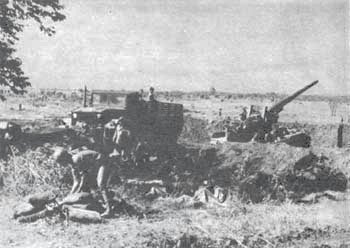
The intent of the Cambodian incursion was to forestall an enemy offensive, despoil the sanctuaries, and, if possible, capture the Central Office. At the same time, the achievement of these objectives would so disrupt Communist plans and capabilities that the Vietnamization program would greatly benefit from the added time gained. South Vietnamese operations into Cambodia commenced on 14 April 1970 with several limited penetrations into the "Angel's Wing" area. These penetrations were followed by a major Vietnamese thrust launched on 29 April 1970. Operation TOAN THANG 42 (Rock Crusher) was initiated by the Vietnamese III Corps attacking with three task forces into the Angel's Wing area and then south into the "Parrot's Beak" area of Cambodia.
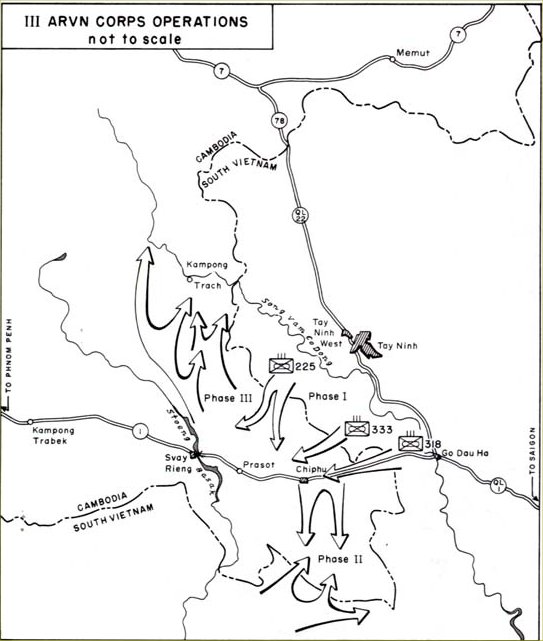
On 27 April 1970, the 1st Cavalry Division was given the mission of planning and executing a campaign to eliminate the North Vietnamese base areas in the Fish Hook region of Cambodia adjacent to Military Region III.
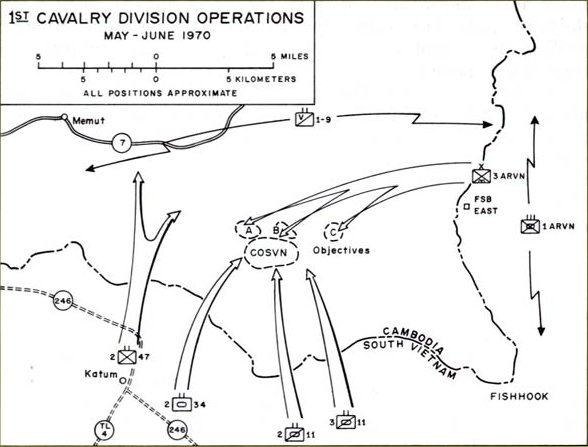
The maneuver plan was simple and direct. The 3d Brigade of the Vietnamese 1st Airborne Division would occupy blocking positions north of the objective area, and elements of the 1st Cavalry Division and the 11th Armored Cavalry Regiment would make a four-pronged attack from the south. Artillery would be provided from all the elements involved in the attack, and additional fire support would come from II Field Force Artillery units.
The fire support available was formidable and included the largest concentration of artillery, tactical air strikes, and B-52 strikes committed in support of an operation of this size by the Free World Military Assistance Forces in the Republic of Vietnam. The fire support coordination planning required to support the operation was extremely complex and detailed. Initially, targeting information was limited; however, after the operation was approved, additional information became increasingly available from II Field Force and Military Assistance Command sources. The bulk of the fire planning was conducted during 27-29 April 1970. After the basic fire support annex and artillery fire support appendix were prepared, detailed coordination of fires with other fire support assets was conducted. Care was taken to insure that the various fire supports did not interfere with each other, times on target were adjusted to insure flight safety for ordnance-carrying aircraft, and definitive air corridors were established. The annex and appendix with target lists and overlays were distributed on 29 April for the D-day H-hour fires and on 30 April for the planned fires in support of subsequent phases of the operation.
Ninety-four cannon artillery pieces were positioned to support the initial phases of the attack: thirty-six 105-mm. howitzers, fortyeight 155-mm. howitzers, four 8-inch howitzers, and six 175-mm. guns. The initial positioning of artillery took place during the period 29 April-1 May 1970. By 30 April (D minus 1), the II Field Force heavy and medium artillery, the direct support artillery for the 3d Brigade, 1st Cavalry Division, and one Vietnamese airborne artillery direct support battery were in position and prepared to support the operation.
At 0600 on 1 May, D-day, an extensive 390-minute planned artillery and air preparation was initiated. Beginning with the 0600 preparation fires, in support of elements of the 1st Airborne Division, until the end of the preparation at 1245, a total of 2,436 artillery rounds was fired. These fires were effectively integrated with 48 tactical airstrikes to complete the D-day preparations. Throughout the morning tactical air and cannon and aerial field artillery were simultaneously employed in the attack on multiple target complexes. The total fire support delivered for D-day operations included 185 tactical air sorties, 36 arc light missions, and 5,460 artillery rounds.
During the period 2-5 May, the detailed fire support planning paid handsome dividends as many lucrative targets were engaged. The heavy concentration of cannon artillery and flexible fire support coordination allowed fires to be massed again and again with relative ease. Artillery moves to support advancing friendly forces began on 2 May and were subsequently made whenever necessary to insure continuous artillery coverage. II Field Force Artillery units alone moved 198 times during the sixty-day operation to maintain pace with the maneuver forces.
On 5 May plans were initiated for an expansion of operations in Cambodia. As a result of the planned expansion, Task Force SHOEMAKER was dissolved and the responsibility for fire support coordination was passed from the task force to the 1st Cavalry Division. With the initiation, of Operation TOAN THANG 45 northeast of Bu Dop by the 2d Brigade of the 1st Cavalry Division, in Base Area 354 by elements of the U.S. 25th Infantry Division, and in Base Area 350 by the Vietnamese 9th Regiment, fire support coordination activities were expanded but did not change significantly from the smooth-functioning procedures previously established. Positioning II Field Force Artillery units centrally and well forward had facilitated the support of the additional maneuver units as they attacked into Base Areas 354, 707, 350, and 351. Except for a few batteries located in critical areas of III Corps, virtually all remaining units of II Field Force Artillery were moved to the Cambodian border or across it. During one three-day period, 32 artillery moves were conducted to place the firing elements in the best positions to support the expanded operations.
During the withdrawal phases of both TOAN THANG 43 and TOAN THANG 45,extraction support plans were formulated to derive maximum benefit from all available fire support. The purpose of these plans was to deny the enemy access to the extraction sites and air corridors. Like the fire plans that had been developed for the conduct of the operation, the extraction support plans were comprehensive and effective. Each direct support artillery battalion planned the extraction fires for the supported brigade, and the division fire support coordination center cooperated closely with the Vietnamese airborne division artillery commander to establish the fire scheme for the withdrawal of the Vietnamese forces. These plans were so effective that continuous fire was maintained around the extraction sites and air corridors during the entire operation. By 1800 on 29 June 1970, all American units were withdrawn from Cambodia.
At the same time that the well-publicized campaign across the Cambodian border was kicking off in the Military Region III area, the 4th Infantry Division, located in the central highlands of II Corps Tactical Zone, received a warning order to be prepared to conduct operations across the border into Base Area 702 to locate and destroy enemy resources, installations, and command facilities. Planning was initiated immediately for the two-brigade assault. Fire support was provided by division artillery units reinforced by medium and heavy elements of the 52d Artillery Group. Division artillery established a forward tactical command post at New Plei Djereng and, in conjunction with a permanent liaison party provided by the 52d Artillery Group, developed the fire support plan for the operation, called BINH TAY I. Because South Vietnamese elements were involved in the operation, it was necessary to form the additional liaison parties to support Vietnamese units. A special fire support team was established with the Special Forces and Civilian Irregular Defense Group unit at New Plei Djereng to insure timely clearance of fire requests. Firing units were positioned in forward areas on 4 May 1970 to facilitate joining the maneuver forces and reduce the time required to lift the units into the selected fire support bases. After the planned occupation of the fire bases by the light and medium artillery batteries, only one battery was relocated within the base area. This move was required because of a decision to increase the troop density in the 1st Brigade area of operation. With this one exception, all artillery units remained in their initial positions throughout the Cambodian operation. Although artillery support,of the operation was adequate, ammunition resupply problems hampered the total effectiveness of the firing units. A temporary ammunition supply point was established at New Plei Djereng; however, its stockage was not in accord with the recommended stockage objective. A critical shortage was avoided only because the initial combat assaults of the maneuver forces were delayed one day. Although significant amounts of material were captured and destroyed, Operation BINH TAY I was less than a total success. Because of other commitments and operational requirements in II Corps, 4th Division elements were withdrawn ten days after the operation started and substantial areas were left unexploited. The lack of air assets, both Army and Air Force, artillery resupply problems, and heavy initial contact severely hampered the efficiency of the operation. Although Vietnamese forces continued to operate in Base Area 702 until 25 May 1970, the major tactical effort was complete with the withdrawal of the 1st Brigade units on 16 May.
The Cambodian incursion was an overwhelming success both in materiel captured or destroyed and the artillery rounds expended in support of the operation. During the two-month assault, friendly units expended 847,558 rounds of which 261,039 were fired by Vietnamese artillery units. Reported surveillance credited artillery units with 253 killed and 70 bunkers and 20 tunnel systems destroyed. Surprisingly, all artillery kills were reported by Vietnamese sources and 230 were reported as a result of the preparation fires that initiated the operation. The 1st Cavalry Division, in whose area of operations 708,965 rounds were fired by both U.S. and Vietnamese field artillery, did not credit the artillery with any kills or any bunker or tunnel destructions.
The Cambodian operation measured in terms of Vietnamization showed that weaknesses in Vietnamese fire support techniques still existed. Vietnamese artillery was not employed to its full effectiveness by task force commanders. Repeatedly, these commanders waited too long for tactical air, gunships, and light fire team support when direct support artillery was within range and ready to provide immediate fire. Throughout the operation, task force commanders called for tactical aircraft and light fire team strikes without regard to the nature of the target being engaged. Often, light fire teams were called to engage well-fortified positions-targets better suited for artillery engagement. This failure to expeditiously engage the enemy materially reduced the effectiveness of the combat mission. Often, Vietnamese artillery liaison officers and forward observers were not properly utilized. On numerous occasions the maneuver element commanders personally adjusted artillery fire and Vietnamese Air Force air strikes although trained observers were available. On several occasions, Vietnamese fire support officers were intimidated by their supported unit commanders to the extent that they would not approach the commanders with recommendations on the use of artillery. These failings resulted in lowering the effectiveness of the fire support and removed the commanders from their more immediate responsibilities of command. In addition, some coordination and liaison problems emerged between U.S. and Vietnamese forces. These problems were most acute whenever U.S. units were under the operational control of Vietnamese commands, and the difficulties manifested themselves in displacement, emplacement, and security arrangements. At times, slow reaction by the responsible Vietnamese headquarters in target clearance matters hampered the ability of the American artillery units to provide responsive fire support to elements in contact.
One of the most significant successes of the Cambodian incursion was really a by product of the action. With Vietnamese troops committed in such large numbers to the operation, territorial security became the primary responsibility of the Regional and Popular Forces. Their reaction to the challenge was surprisingly good and, more important, the confidence they gained from their successes served as a valuable psychological boost.
